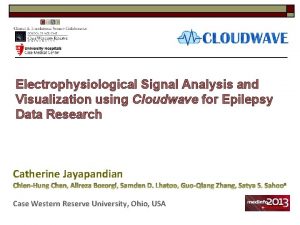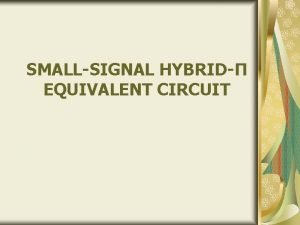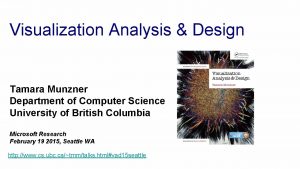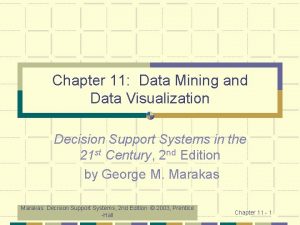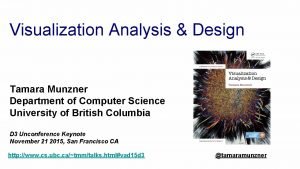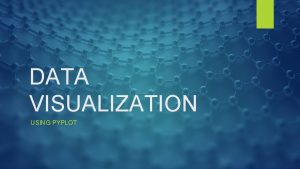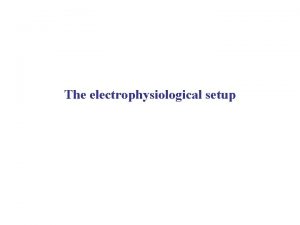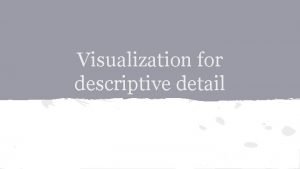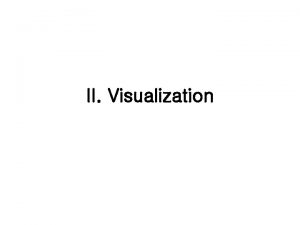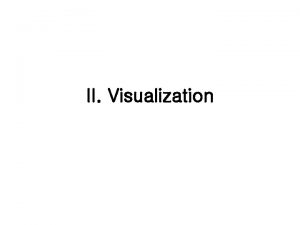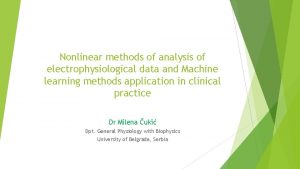Electrophysiological Signal Analysis and Visualization using Cloudwave for











- Slides: 11

Electrophysiological Signal Analysis and Visualization using Cloudwave for Epilepsy Data Research Catherine Jayapandian Case Western Reserve University, Ohio, USA

Outline of the talk o o o Background: Electrophysiological Data Management Challenges: Big Data, Multicenter studies Cloudwave Framework: Features, Components Current Results Future Directions

Background o What is Epilepsy? n o Most common neurological disorder affecting 60 million worldwide How is Epilepsy detected? n n Multi-modal Electrophysiological evaluations like EEG, EKG, BP, O 2 and CO 2, Sleep data, video Electroencephalogram (EEG) is the gold standard for diagnosis and pre-surgical evaluation

PRISM o Multi-center Clinical Study for Prevention and Identification of Risks in SUDEP Patients o Key Components n MEDCIS Multimodality Epilepsy Data Capture and Integration System n OPIC Online Patient Information Capture n Epi. DEA Epilepsy Data Extraction and Annotation n Cloudwave Electrophysiological Signal “Big Data” on the Cloud

Cloudwave Features o o Ontology-driven Webbased Electrophysiological Epilepsy Signal Query, Visualization and Analysis Framework Provides High Performance Cloud Computing Infrastructure for handling Electrophysiological “Big Data”

Cloudwave Components o o Patients Cohorts are selected using the MEDCIS Query Builder Patient ID is linked to Cloudwave Signal Viewer All studies and the related seizure events for the patient can be viewed using Cloudwave interface

Components (contd. ) o o Selection of Patient Study, Montage, Signal/Channels for display Facilitate creation of new montages (referential and bipolar)

Components (contd. ) o Selection of Seizure Events/Annotations Mouse zooming to timerange of interest Exporting as image and printing Visually navigate using scroll to select time-range

Components (contd. ) o Selection of Filters – Sensitivity, HF Filter and Time Constant

Future Directions o Electrophysiological “Big” Signal Data Storage on HDFS by collecting similar signals for correlation and quantitative signal analysis using Map. Reduce distributed processing n o Cloudwave: Distributed Processing of “Big Data” from Electrophysiological Recordings for Epilepsy Clinical Research Using Hadoop, AMIA 2013 (accepted) Computation of complex Signal Processing algorithms – Cardiac Arrhythmia, Respiratory Arrhythmia and related measurements for real-time rendering on Cloudwave web interface (work in progress)

Take home points o o o PRISM is NIH funded, multi-disciplinary and multicenter (4 participating centers) – recruiting 1200 patients Cloudwave establishes the capability for comprehensive comparative studies of SUDEP and near-SUDEP cases vs. cohort survivors Cloudwave is a key component of PRISM project– facilitate the management of Electrophysiological “Big” Data and Real Time Web Rendering of Multimodal signals For more details, please visit: http: //prism. case. edu Contact: Catherine Jayapandian (cpj 3@case. edu)
 Signal analysis and visualization
Signal analysis and visualization Bjt small signal equivalent circuit
Bjt small signal equivalent circuit Baseband signal and bandpass signal
Baseband signal and bandpass signal Baseband signal and bandpass signal
Baseband signal and bandpass signal Classification of signals
Classification of signals Tamara munzner data visualization
Tamara munzner data visualization Digital signal as a composite analog signal
Digital signal as a composite analog signal Market basket analysis visualization
Market basket analysis visualization Visualization analysis & design
Visualization analysis & design Write directions using signal words
Write directions using signal words Iso 22301 utbildning
Iso 22301 utbildning Typiska drag för en novell
Typiska drag för en novell
